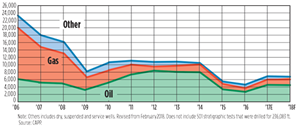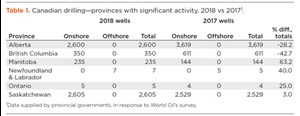Canada suffers from logistical issues and political uncertainties
Climate change policy remains a hot political issue in 2018, with Ontario’s new Conservative government adamantly opposed to the implementation of the federal carbon tax, joining Saskatchewan in its fight against Ottawa’s plans. In July, Prince Edward Island voiced its opposition, and it appears that other maritime provinces may follow. In the meantime, Alberta is proceeding with measures to reduce methane/CO2 emissions from industry operations. However, environmentalists are claiming they don’t go far enough, and industry is raising concerns about incurring significant costs to meet them.
TransMountain pipeline. Prime Minister Trudeau’s hesitance to assert (rightful) jurisdiction over the TransMountain expansion project seemingly emboldened protesters and encouraged interference by British Columbia’s government. But just when Kinder Morgan seemed ready to abandon its plans, the feds further muddied the waters by announcing in May that they would purchase the TransMountain pipeline for C$4.5 billion. After clearing a U.S. national security review, the sale, which also includes an additional, federal C$1-billion credit facility, should close later this year. The purchase will now cost Canada an additional C$1.9 billion, and the in-service date will be much later than planned.
Curiously, while the purchase of TransMountain was being discussed and negotiated, Trudeau’s Liberals proceeded with proclaiming Bill C-48, the Oil Tanker Moratorium Act, which prohibits tankers carrying more than 12,500 tonnes of crude from stopping at any port on much of B.C.’s coast. The bill now faces a court challenge from an indigenous-owned company called Eagle Spirit that proposes to build a 930-mi pipeline to carry up to 2 MMbopd from the Fort McMurray area to the coast.
Meanwhile, the project’s future is in doubt, after Canada’s Federal Court of Appeal overturned the approval issued by cabinet, due to two issues. First, the National Energy Board ruled that it would not consider the project’s impact on marine shipping. Second, the Court ruled that the federal government failed in its duty to engage in meaningful consultations with First Nations about the proposed pipeline.
Despite opponents’ claims that the court ruling effectively quashes the approval, that is not the case. The ruling clearly set forth what conditions must be satisfied to issue an approval. Curiously, Trudeau has asserted that the ruling is good news, a view not shared by the Canadian industry.
Transportation slowdowns. The ongoing lack of pipeline capacity has created several associated issues, including: 1) an increase in oil shipped by rail (which hit an all-time high this summer; 2) unnaturally low prices for Alberta producers, and most critically; 3) a continued lack of confidence among producers that they will have the required market access in the future. Adding uncertainty is the August ruling by a Montana federal judge that ordered the U.S. State Department to conduct a full environmental review of Keystone XL’s revised route.
Uptick in crude prices. On the positive side, oil prices are up 30% over 2017 levels, with the differential between Alberta spot prices and WTI narrowing slightly this summer. Unfortunately, natural gas prices have trended the opposite direction, with spot prices hitting a low of negative C$0.07 at Alberta’s AECO hub in May of this year. Nonetheless, industry observers believe annual cash flow may increase as much as 20% in 2018.
The industry is also wary of federal bill C-69, which drastically changes the structure of the National Energy Board, the federal regulator. Touted by the Liberal government as an improvement to existing rules that will speed up regulatory reviews, it faces mounting opposition across Canada. Alberta has raised concerns, while Saskatchewan and Ontario jointly condemned the legislation, stating that “The changes in the new Impact Assessment Act would result in a more complex, costly and time-consuming process, while creating uncertainty that could ultimately erode Canada’s economic competitiveness.”
Shaky foundation. Businesses looking to site capital intensive projects in Canada —like LNG terminals—are understandably skeptical of a political environment that is widely unpredictable (at best) and openly hostile (at worst), despite the massive benefit to local, provincial and national economies. Canada’s difficulties getting LNG terminals is testament to this concern, with only one operating facility, in Saint John, New Brunswick. There are 20 proposed projects, 14 of which are planned for B.C. In May, one year after announcing it was pulling out of its own LNG terminal, Malaysian NOC Petronas said it was buying a 25% stake in LNG Canada, led by Shell.
Flagging Canadian dollar benefits sellers. The mixed bag means continued caution from the Canadian industry, which expects to see spending and activity (Fig. 1) remain mostly flat this year, compared to 2017. The Canadian dollar has slumped in recent months vs. its U.S. counterpart, a positive development for Canada’s export-driven resource sector. For companies exporting hydrocarbons to the Americans, getting paid higher-valued U.S. dollars means collecting a premium on every bbl of oil and cubic ft of gas sold.
M&As decelerate. Market turbulence and uncertainty often create opportunities for well-positioned companies to make high-value acquisitions. But unlike first-half 2017, which saw several massive deals, 2018 has been quiet, with some $8 billion of transactions, compared to $27 billion in first-half 2017. The biggest deal was Shell’s divestiture of its 7.98% stake in Canadian Natural Resources, for $3.3 billion in May.
In June, Baytex Energy and Raging River Exploration completed a $1.5-billion all-stock deal, following Raging River’s announcement in May that it was seeking buyers. Baytex will acquire 24,000 boed, increasing total production to over 90,000 boed.
In July, Enbridge Inc. announced it would be selling its natural gas gathering and processing assets in the Horn River, Liard, Montney and Peace River Arch areas to Brookfield Infrastructure for a cash deal valued at C$4.3 billion.
Despite expected increases in cash flow, due to improving oil prices, spending remains flat, reflecting the caution still prevalent in the industry. Canada’s largest producer, Canadian Natural Resources, recently announced a modest increase in its 2018 capex plans, to C$4.6 billion, but that is still down slightly from C$4.86 billion in 2017.
Husky Energy was more bullish, announcing it would increase its spending to approximately C$3 billion this year, compared to C$2.2 billion in 2017. Crescent Point Energy also is on track to increase spending in 2018, to C$1.8 billion, although the company indicated it was moving some of its spending plans into the fourth quarter, and possibly into 2019.
Oil sands recover. Alberta’s oil sands are seeing an upswing in activity, as several operators have filed applications for new projects, or expansions to existing schemes. In September, Teck Resources will appear at a joint Canada/Alberta hearing to argue its case in support of its proposed 260,000-bpd Frontier truck-and-shovel mine.
In August, CNRL applied to the Alberta Energy Regulator to increase bitumen production at its Horizon mine by 45,000 bpd. The company hopes to begin construction in third-quarter 2019.
Japan Canada Oil Sands announced positive results at its Hangingstone SAGD expansion in June, reaching 23,492 bpd, which is higher than its expected 20,000 bpd. Also in June, Prosper Petroleum received regulatory approval to proceed with its Rigel SAGD project in northeastern Alberta.
Land sales were consistent with last year’s numbers through first-half 2018, after totals jumped in 2017. Through the first six months of 2018, according to Daily Oil Bulletin records, spending in Western Canada was C$276.57 million, down 1.3% from the C$276.57 million collected in the first half of 2017, but well below the 2006 record, when governments took in C$2.66 billion.
Alberta once again led the way, taking in 65% of the total amount, C$191.25 million, up 6.2% over the C$180.13 million collected in 2017. Much of the spending in Alberta this year has been driven by interest in the Duvernay play.
Spending in B.C. has tapered off slightly through six months, with the province taking in C$59.44 million, a decrease of 15.4% over the C$70.28 million collected in first-half 2017. Despite the decline, this year’s activity is still substantially higher than the C$4.2 million garnered through June in 2016.
Saskatchewan’s totals also were down 15.4% through six months, hitting C$21.94 million at the halfway point of 2018, compared to C$25.94 million in 2017.
Drilling activity. First half numbers are down slightly in year-over-year comparisons, with 3,149 wells drilled, compared to 3,316 in 2017, a 5% reduction. Of the total drilled in 2017, 84% targeted oil, according to Daily Oil Bulletin records. Overall, footage drilled increased slightly.
World Oil survey results show (Table 1) Alberta projecting a decrease, while CAPP is calling for 6,800 wells to be drilled across Canada, compared to 6,913 last year.
Canada’s service industry associations are split on the drilling outlook for the remainder of 2018. The Canadian Association of Oilwell Drilling Contractors is predicting that 6,138 wells will be drilled this year, up just 100 from the 6,031 wells drilled in 2017.
Meanwhile, the Petroleum Services Association of Canada recently revised its forecast for the second time since its original forecast in November last year, and now predicts that 6,900 wells will be drilled (down from its forecast of 7,400 in April), and substantially lower than its original projection of 7,900 wells. ![]()
- Applying ultra-deep LWD resistivity technology successfully in a SAGD operation (May 2019)
- Adoption of wireless intelligent completions advances (May 2019)
- Majors double down as takeaway crunch eases (April 2019)
- What’s new in well logging and formation evaluation (April 2019)
- Qualification of a 20,000-psi subsea BOP: A collaborative approach (February 2019)
- ConocoPhillips’ Greg Leveille sees rapid trajectory of technical advancement continuing (February 2019)




